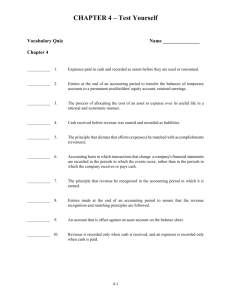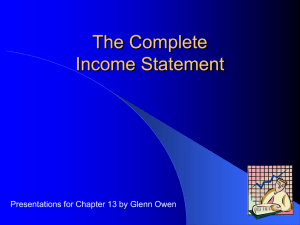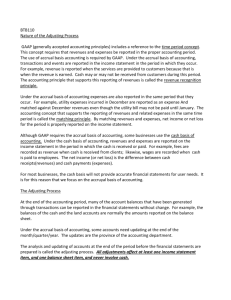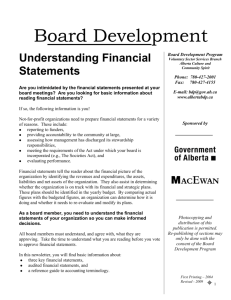The Accounting Model Comprehension Quiz Solution
advertisement
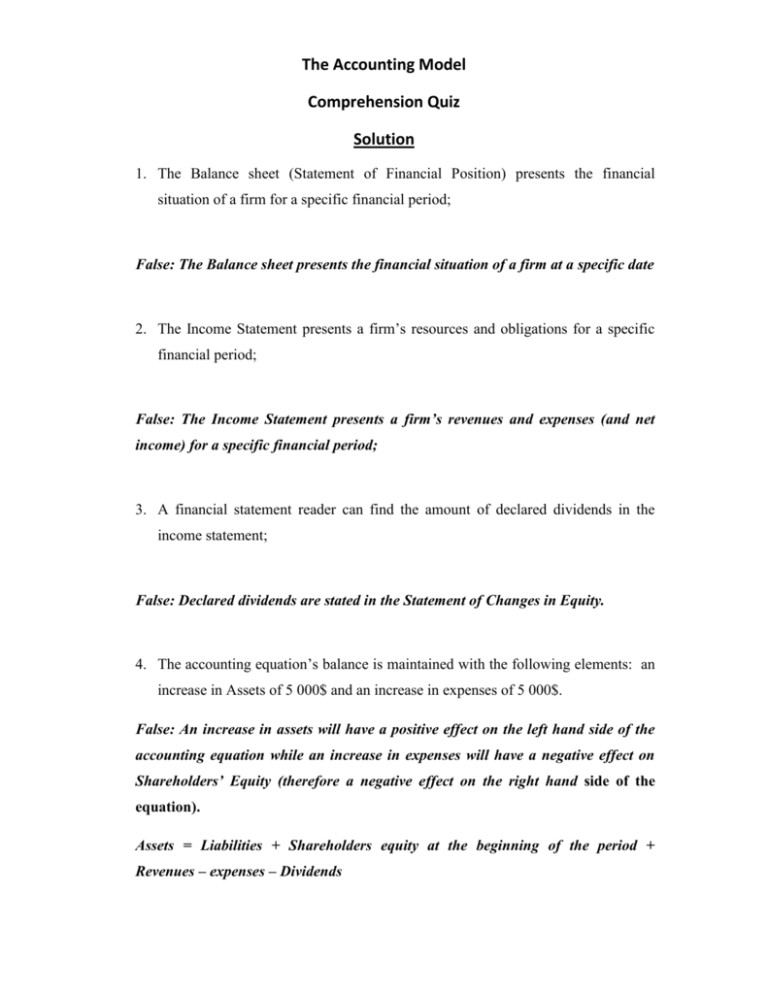
The Accounting Model Comprehension Quiz Solution 1. The Balance sheet (Statement of Financial Position) presents the financial situation of a firm for a specific financial period; False: The Balance sheet presents the financial situation of a firm at a specific date 2. The Income Statement presents a firm’s resources and obligations for a specific financial period; False: The Income Statement presents a firm’s revenues and expenses (and net income) for a specific financial period; 3. A financial statement reader can find the amount of declared dividends in the income statement; False: Declared dividends are stated in the Statement of Changes in Equity. 4. The accounting equation’s balance is maintained with the following elements: an increase in Assets of 5 000$ and an increase in expenses of 5 000$. False: An increase in assets will have a positive effect on the left hand side of the accounting equation while an increase in expenses will have a negative effect on Shareholders’ Equity (therefore a negative effect on the right hand side of the equation). Assets = Liabilities + Shareholders equity at the beginning of the period + Revenues – expenses – Dividends 5. The accounting equation’s balance is maintained with the following elements: a decrease in assets of 10 000$ and a decrease in liabilities of 10 000$; True 6. The Statement of Cash flows illustrates the variation of cash inflows and outflows involved in the 3 main activities of a business for a given financial period; True 7. The two fundamental principles of income measurement are the cost principle and the matching principle. False: The two fundamental principles of income measurement are the matching principle and the timing of revenue recognition principle 8. Marketable securities are cash substitutes temporarily invested to earn higher returns than bank accounts. True 9. Accounting standard setters recommend to take an allowance for doubtful accounts mainly to comply with the cost principle; False: Accounting standard setters recommend taking an allowance for doubtful accounts mainly to comply with the matching principle and the conservatism principle. 10. The gain from sale of fixed assets has a positive effect on cash flows and is presented in the Statement of Cash Flows under investing activities; False: The gain from sale of fixed assets has no effect on cash flows but is accounted for as revenue in the Income Statement. However, the cash obtained according to the price of sale of assets is presented in the Statement of Cash Flows as an inflow related to “Investment activities”. 11. Prepaid expenses are certain expenses that are paid for and consumed before the balance sheet date. False: Prepaid expenses are certain expenses that are paid for but not yet consumed (incurred) at the balance sheet date. 12. Unearned revenues are amounts received for revenues that are not reported as sales before the balance sheet date; True 13. Goodwill is the difference between the price paid to acquire a firm and the net book value of the acquired firm’s assets. False: Goodwill is the difference between the price paid to acquire a firm and the market value of the acquired firm’s net identifiable assets. 14. The net book value (NBV) of an asset is the asset’s cost less its cumulated depreciation; True 15. When there is a payment of 5000 $ (4000$ for reimbursement of capital and 1000$ for the interest) on a long term debt, there is a decrease of 5000$ in both assets and liabilities; False: When there is a cash payment of 5000 $ (4000$ on the capital and 1000$ on the interest) on a long term debt, there is a decrease of 5000$ in assets, a decrease of 4000$ in liabilities and an increase of 1000$ in the expenses (which results in a decrease of 1000$ in Shareholders’ Equity). 16. The two different methods (direct and indirect) that may be used to produce the Statement of Cash flows differ mainly in investing activities; False: The two different methods (direct and indirect) that may be used to produce the cash flow statement differ mainly in the presentation of the operating activities (activities from operations). 17. We should use the straight line depreciation method for assets that will be used evenly throughout the years of their useful life; True 18. We should not use the FIFO (first in, first out) inventory method when we sell very different and very valuable goods. True The following values are determined as follows: a. Gain or loss on sale of assets; Sale price – net book value (NBV) of asset NBV of an asset = Cost of asset – Cumulated depreciation. b. The year-end balance of retained earnings; Beginning balance of retained earnings + Net Income –Declared dividend= End balance of retained earnings. c. The amount of sales in cash (or cash received from customers) that we find in the operating activities section of the Statement of Cash Flows if presented according to the direct method: Sales + Accounts receivable (beginning balance) - Accounts receivable (end balance) + Unearned revenues from sales (end balance) Unearned revenues from sales (beginning balance)







